Energy Storage Systems
-
- Energy Storage Systems Continue to Expand in North American Maritime Markets Marine News, Jan 2021 #38
North America is increasingly adopting energy storage systems (ESS) to use in combination with combustion engines or as the sole energy carrier in fully electric-powered systems.
We clearly see a transition from ‘consideration’ to ‘execution’ of hybrid and all-electric maritime projects. Stakeholders want to explore how to make vessels more energy efficient and less polluting. Corvus Energy has deployed over half of the ESSs aboard vessels globally, totaling over 300 megawatt hours (MWh).
In North America, Corvus has deployed 24 MWh of energy storage capacity, and there are 13 vessels under U.S. Coast Guard jurisdiction and nine with Canadian flag either commissioned or under construction.
Trends in ESS technology
Just a few years ago, battery size was the main consideration. Corvus would analyze a vessel’s load profile and size the battery system to exactly meet anticipated loads. However, as battery costs go down, other cost factors in the complete electrical solution rise to prominence. Now we see a more relaxed approach to battery sizing, as owners discover operational flexibility in higher battery capacity.Different types of vessels have widely varying energy storage and charge/discharge requirements. As such, Corvus has developed a portfolio of energy storage solutions that take advantage of the strengths of selected battery cell technology to offer differing performance characteristics.
The following describes the ESSs we deploy on board vessels, their distinguishing features, and their most suitable applications:
Orca — Robust flexibility with fast-charging capability
Corvus Orca is our most widely selected battery system worldwide due to its scalability, fast charge/discharge capabilities, and ease of installation. It uses a Li-NMC cell and patented technology to optimize safety and performance.It was Orca that broke through the cost/benefit intersection, raised the bar for maritime battery safety standards, and started rapid adoption in Nordic countries. Corvus Orca is now deployed on more than 200 vessels worldwide and has surpassed 2 million operating hours. It has proven to suit many vessel types and operating profiles, including offshore support vessels and shuttle tankers, car and passenger ferries, coastal cargo vessels, workboats, tugboats and fishing/fish farm vessels.
Dolphin — The highest energy density for weight-sensitive applications
For weight-sensitive vessels, such as fast-ferries and high-speed workboats, Corvus Dolphin may be a better choice. Its very high energy density can allow for more batteries on board, which may reduce how often they need to be charged. One of the trade-offs is a slightly reduced charging speed compare to Orca. As weight-sensitive fleets are electrified, operators may need to reconsider route scheduling. For example, a couple minutes more at the dock might represent significant reduction in shore power requirements.Corvus Dolphin is available in power- and energy-optimized versions. Like Orca, both Dolphin Energy and Dolphin Power have Li-NMC cells and are modular and scalable for ease of installation.
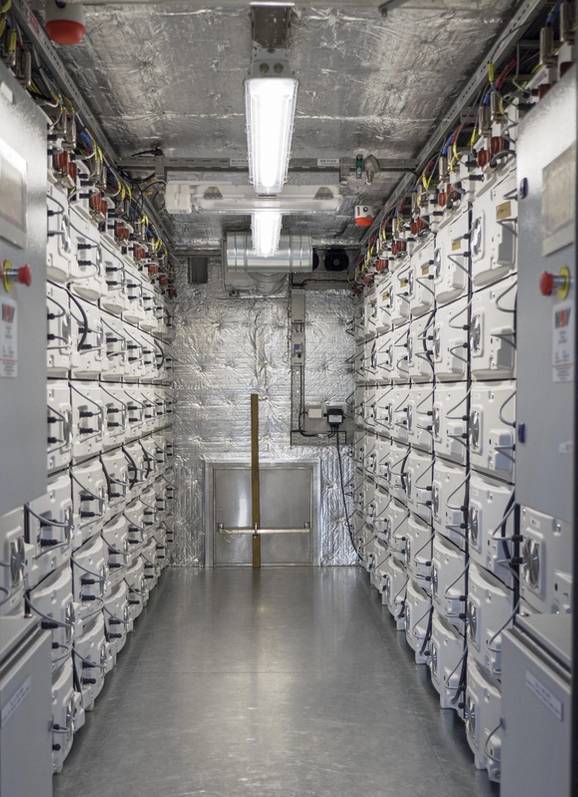 The Corvus Dolphin ESS, with the industry’s highest energy density, is ideal for high-speed vessels and other weight-sensitive applications. (Photo: Corvus Energy)
The Corvus Dolphin ESS, with the industry’s highest energy density, is ideal for high-speed vessels and other weight-sensitive applications. (Photo: Corvus Energy)Blue Whale — Highest energy capacity and battery room volumetric energy density
Corvus developed the Blue Whale ESS with big ships—ferries, cruise ships and cargo vessels—in mind from day one. Blue Whale has the industry’s highest volumetric density, as it is designed to very efficiently be stacked in large battery rooms with service access from the top.The cell technology is LiFePO4 (also called LFP), which provides excellent depth of discharge. This cell characteristic is vital when large ships aim for longer durations with zero emissions, for example, port stays and voyages in fjords or other waterways within sensitive environments or populated areas.
ESS — a partner in power
In an all-electric vessel, the ESS supplies power to the vessel’s electrical components, including propulsion motors. It’s that simple.For a hybrid vessel, the batteries are “a partner in power” with diesel or gas engines. A properly integrated battery system optimizes the power plant at all times. It absorbs load variations and provides power instantly as needed, which often means avoiding starting backup engines. The batteries can also store regenerative power from cranes, winches and similar equipment. Overall fuel savings for vessels with complex load profiles can be in the 20%-30% range.
Corvus ESSs are built upon an open interface platform that can connect with any electrical system, providing vessel owners freedom of choice. Worldwide, we have interfaced our batteries to more than 25 electrical integrators. As we expand our portfolio of ESSs, vessel owners and electrical integrators will be able to select the most suitable battery system without major changes to their Power Management Systems.
Sizing of systems and lifecycle expectations
Designing, building, and operating a hybrid vessel requires different thinking, and Corvus supports the development of operational philosophies with batteries as an essential part of the power plant design. Once operating parameters are determined, Corvus can determine required energy capacity and lifecycle expectation.The industry has mostly settled on a 10-year lifecycle, although that can be adjusted primarily with battery size selection. Corvus offers shipowners real-time battery monitoring, accessible through a cloud-based portal, that tracks actual battery usage and state-of-health to optimize the battery’s performance throughout its lifecycle.
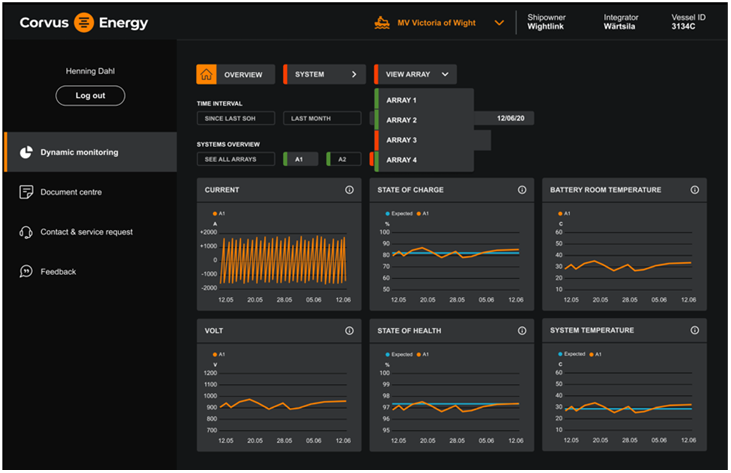 The Corvus customer portal provides shipowners a real-time view of battery state-of-health throughout its lifecycle to optimize performance. (Image: Corvus Energy)
The Corvus customer portal provides shipowners a real-time view of battery state-of-health throughout its lifecycle to optimize performance. (Image: Corvus Energy)Container-based solutions, driven by industry stakeholders
Another trend is to deliver systems in enclosures based on standard container dimensions. Traditionally used in retrofit projects, we see an increasing number of new constructions leaning toward containerized solutions. The packaging allows owners and charterers to look at energy systems as building blocks. In the future, vessels may be capable of adjusting the number of containers on board to change its hybrid profile without intrusive rebuilds.We also see potential to combine containerized batteries with clean energy carriers, such as hydrogen, to store excess energy generated in fuel cells and offload the vessel’s peak demands.
New technology is welcomed
In recent years, we have witnessed a groundswell of acceptance of battery technology as a viable and practical solution to fleet electrification. There is no longer any doubt that the future is electric, but we still have a long way to go on our way to zero emissions.Working together across the industry will be a key to success. Corvus keeps future trends in mind when designing our products, and we always strive to make them as adaptable as possible to existing and emerging standards. We look forward to continued discussions and collaboration within the North American maritime industry, its shipowners, vendors, class societies, trade organizations and government to drive innovation further.
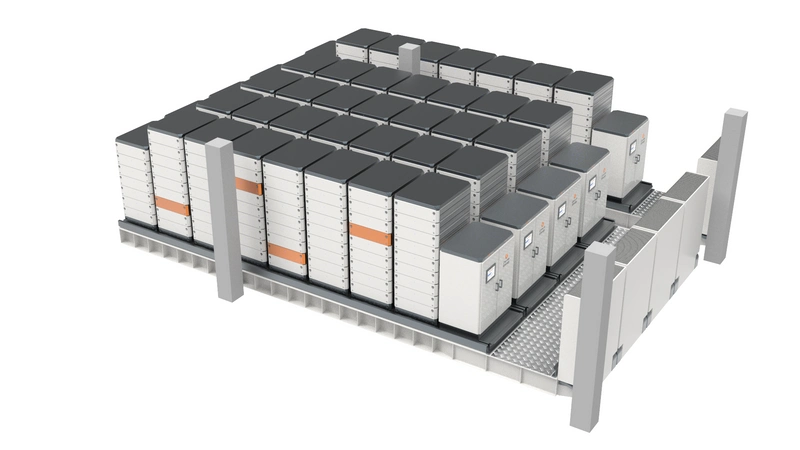 Corvus Blue Whale, a compact ESS to optimize battery rooms in large-scale systems (Image: Corvus Energy)
Corvus Blue Whale, a compact ESS to optimize battery rooms in large-scale systems (Image: Corvus Energy) -
- Tech File: Propelling Hybrid Electric Solutions Marine News, Jan 2017 #50
, a hybrid power system could reduce the minimum number of diesel generators that are required to run constantly. This is possible because the energy storage systems ([ESS], i.e., lithium batteries or super-capacitors) can provide the added power for the occasional peak demand caused by shifting currents
-
- For Ferries to Go Green, Governments Will Need to Provide the Green Marine News, Feb 2024 #16
million award, $15.9 million was directed to the Water Emergency Transportation Authority (WETA) for upgrading its ferry floats to include battery energy storage systems. WETA operates throughout the San Francisco Bay, providing critical transbay services and reducing road congestion. Over the last two years
-
- MN: Corvus Energy Marine News, Aug 2015 #20
The Company: Corvus is a manufacturer of proven, high power Energy Storage Systems (ESS). Its field proven battery systems provide power to hybrid and fully electric marine propulsion systems. Founded in 2009, Corvus provides purpose-engineered ESS solutions for marine, oil & gas and port applications.
-
- Energy Storage Life Cycle Cost Study Marine News, May 2019 #44
can work with the systems engineers for these manufacturers to determine the best system for a particular application. Typical Benefits of Energy Storage SystemsFor typical marine applications, the use of Lithium Ion batteries (Li-ion) will add spinning reserve, peak shaving, and efficient engine loading
-
- Zero Emission Vessels – The Tide is Turning Marine News, Dec 2014 #24
Battery based energy storage systems for marine applications are finally moving, cleanly along the global waterfront at full speed. The UN Report on climate change on November 2, 2014, stated that the unregulated use of carbon based fuels must cease by the end of the century. While people can debate the
-
- Batteries: Ready to Scale Up Marine News, Jul 2022 #26
a lithium ion battery manufacturing facility in Port Bellingham, Wash., just north of Seattle. Corvus Energy is a leading supplier of battery energy storage systems (BESS) for marine applications. Its systems already power more than 30 North American vessels, as well as 29 hybrid port cranes and 11 land-based
-
- Interview: Dirk Balthasar, President, Thermamax Maritime Reporter, May 2019 #26
marine application. Also, on board ships electrification is becoming more and more important. Thermamax battery housings can be used for on-board energy storage systems, replacing conventional Diesel generators. Our battery housings ensure effective fire protection and extend the battery range by balanced thermal
-
- Marine Battery Systems Come of Age Marine News, Dec 2016 #48
design review, sample testing and verification of product controls. Beyond this, Seanergy is also DNV certified. Most recently, Saft’s Seanergy energy storage systems received approval from the Norwegian Maritime Authority. With SLFP chemistry, the batteries passed every simulated thermal runaway test. Because
-
- Marine Hybrid quietly arrives … positioned to explode Marine News, Mar 2019 #48
limited, the public surrounds the services and speeds are typically restricted. Growth outside of these markets will depend on the expansion of the energy storage systems. Despite these restrictions, the growth in the number of services has not been limited. And that is an important factor to analyze.Ferry system
-
- The (Battery) Power Play Maritime Reporter, Apr 2017 #26
on some level. We like the guys. I like boat builders.” Lucrative Growth Perry’s “capacity of capacity” stands at 43 megawatt hours of energy storage systems (batteries plus intel). “With this set up alone we’ll be able to deliver about 120 MWh,” he says. Steady business is already ratcheting up
-
- Hybrid drives: Siemens sends in the machines Maritime Reporter, Feb 2020 #46
for every 0.256 of fish, a nod to fishing hard on marine fuel.His point made, Moen walks us into Siemen’s brand-new factory for making marine energy storage systems, or ESS, the heart of a plan to equip and sell more BlueDrive Plus C drives. The new drive is said to be a safer, more profitable and a greener
-
 )
November 2024 - Marine News page: 48
)
November 2024 - Marine News page: 48, Vice President of cutting-edge propulsion technology and pioneering bat- Industrial Electri? cation, Automation and Digitalization tery energy storage systems. It is said to be the ? rst ferry Solutions in North and South America for Siemens En- to operate under U.S. Coast Guard Subchapter H with
-
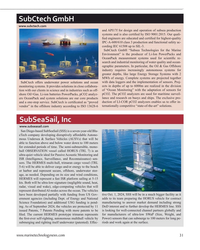 )
September 2024 - Marine Technology Reporter page: 31
)
September 2024 - Marine Technology Reporter page: 31parameters. In particular, the Oil & Gas Offshore industry requires increasingly autonomous systems for greater depths, like large Energy Storage Systems with 2 MWh of energy. Complete systems are projected together SubCtech offers underwater power solutions and ocean with data loggers and
-
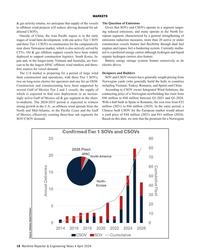 )
April 2024 - Maritime Reporter and Engineering News page: 18
)
April 2024 - Maritime Reporter and Engineering News page: 18logistics. South Korea, Ja- organic hydrogen carriers also feature. pan and, in the longer-term, Vietnam and Australia, are fore- Battery energy storage systems feature extensively as do cast to be the largest APAC offshore wind markets and there- electric drives. fore sources for vessel demand. The
-
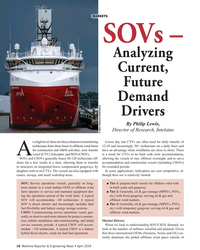 )
April 2024 - Maritime Reporter and Engineering News page: 16
)
April 2024 - Maritime Reporter and Engineering News page: 16. SOV is diesel electric and increasingly includes dual ¦Tier 3: Generally, oil & gas tonnage (MPSVs, PSVs, fuel ? exibility and battery energy storage systems. etc.) with temporary gangway, serving oil & gas and CSOV: Commissioning service operations vessel, gen- offshore wind markets. erally
-
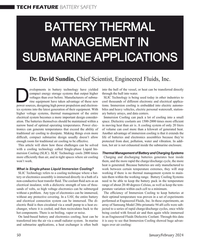 )
January 2024 - Marine Technology Reporter page: 50
)
January 2024 - Marine Technology Reporter page: 50, Engineered Fluids, Inc. evelopments in battery technology have yielded into the hull of the vessel, or heat can be transferred directly compact energy storage systems that output higher through the hull into water. voltages than ever before. Manufacturers of subma- SLIC Technology is being used today in
-
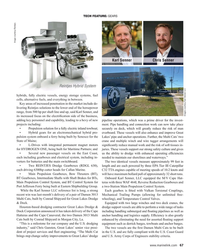 )
November 2023 - Maritime Reporter and Engineering News page: 67
)
November 2023 - Maritime Reporter and Engineering News page: 67TECH FEATURE: GEARS Image courtesy Reintjes Karl Senner Chris Senner Reintjes Hybrid System hybrids, fully electric vessels, energy storage systems, fuel cells, alternative fuels, and everything in between. Key areas of increased penetration in the market include de- livering Reintjes
-
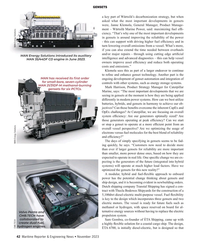 )
November 2023 - Maritime Reporter and Engineering News page: 42
)
November 2023 - Maritime Reporter and Engineering News page: 42its ? rst order ongoing development of genset automation and integration of for small-bore, seven-cylinder controls with other systems, such as energy storage systems. MAN 21/31DF-M methanol-burning Mark Harrison, Product Strategy Manager for Caterpillar gensets for six PCTCs. Marine, says: “The most important
-
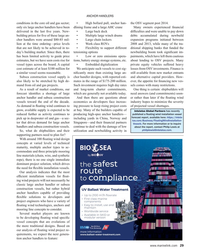 )
August 2023 - Maritime Reporter and Engineering News page: 29
)
August 2023 - Maritime Reporter and Engineering News page: 29to guide price • Low or zero emissions opera- pairments, which have left them cautious estimates, but we have seen costs rise for tions, battery energy storage systems, etc. about lending to OSV projects. Many vessel types across the board. A capital • Embedded digitalization private equity vehicles suffered
-
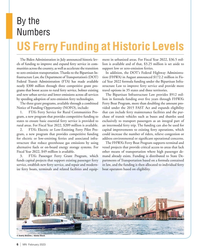 )
February 2023 - Marine News page: 6
)
February 2023 - Marine News page: 6. structure that reduce greenhouse gas emissions by using The FHWA’s Ferry Boat Program supports terminal and alternative fuels or on-board energy storage systems. For vessel projects that provide critical access to areas that lack Fiscal Year 2022, $49 million is available. other means of transportation
-
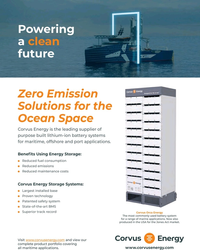 )
January 2023 - Maritime Reporter and Engineering News page: 3
)
January 2023 - Maritime Reporter and Engineering News page: 3offshore and port applications. Bene? ts Using Energy Storage: Reduced fuel consumption Reduced emissions Reduced maintenance costs Corvus Energy Storage Systems: Largest installed base Proven technology Patented safety system State-of-the-art BMS Superior track record Corvus Orca Energy The
-
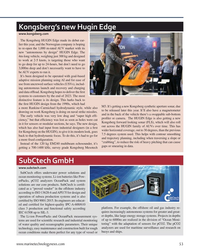 )
September 2022 - Marine Technology Reporter page: 53
)
September 2022 - Marine Technology Reporter page: 53and functional safety according quires increasingly autonomous systems for greater and great- IEC 61508 up to SIL-3. er depths, like large energy storage systems. Projects in depths The Li-ion PowerPacks and OceanPack measurement sys- tems are used for scienti? c research and industrial monitoring
-
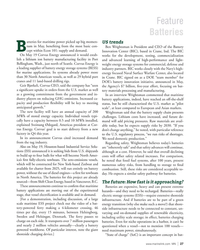 )
July 2022 - Marine News page: 26
)
July 2022 - Marine News page: 26facility in Port and advanced learning of high-performance and light- Bellingham, Wash., just north of Seattle. Corvus Energy is weight energy storage systems for commercial, defense and a leading supplier of battery energy storage systems (BESS) industry partners. BIC works closely with the Navy’s
-
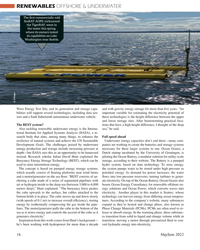 )
May 2022 - Marine Technology Reporter page: 16
)
May 2022 - Marine Technology Reporter page: 16Battery is a pumped used to store intermittent energy. hydro system, based on dam technology. To store energy, The concept is based on pumped energy storage systems, the system pumps water to be stored under high pressure as which usually consist of ? oating platforms near wind farms potential energy
-
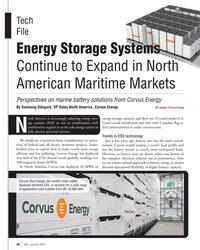 )
January 2021 - Marine News page: 38
)
January 2021 - Marine News page: 38Tech File Energy Storage Systems Continue to Expand in North American Maritime Markets Perspectives on marine battery solutions from Corvus Energy By Sveinung Odegard, VP Sales North America, Corvus Energy All images: Corvus Energy orth America is increasingly adopting energy stor- energy storage
-
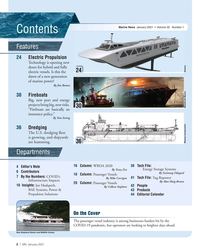 )
January 2021 - Marine News page: 2
)
January 2021 - Marine News page: 2shipyards Manson Construction MetalCraft Marine Glosten are humming. 36 Departments 16 Column: WRDA 2020 38 Tech File: 4 Editor’s Note Energy Storage Systems By Tracy Zea 6 Contributors By Sveinung Odegard 18 Column: Passenger Vessels 7 By the Numbers: COVID’s 41 Tech File: Tug Repower By
-
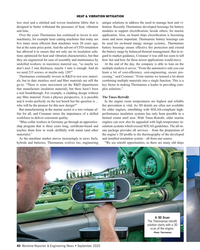 )
September 2020 - Maritime Reporter and Engineering News page: 40
)
September 2020 - Maritime Reporter and Engineering News page: 40are more and more important. Thermamax battery housings can ? ve times more ef? cient than machines were 20 years ago, be used for on-board energy storage systems,. Thermamax but at the same price point. And the advent of CFD simulation battery housings ensure effective ? re protection and extend has
-
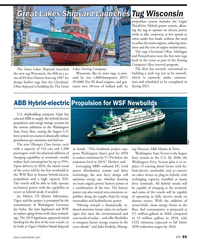 )
July 2020 - Marine News page: 55
)
July 2020 - Marine News page: 552021. $%%+\EULGHOHFWULF3URSXOVLRQIRU:6)1HZEXLOGV U.S. shipbuilding company Vigor has selected ABB to supply the hybrid-electric propulsion and energy storage systems for the newest additions to the Washington State Ferry ?eet, setting the largest U.S. ferry system on course to drastically reduce greenhouse
-
 )
February 2020 - Maritime Reporter and Engineering News page: 48
)
February 2020 - Maritime Reporter and Engineering News page: 48made, Moen walks us into was what we were watching, as robots Siemen’s brand-new factory for making simulated bent, burdened backs and marine energy storage systems, or ESS, the tool-twists of a handful of techni- the heart of a plan to equip and sell more cians. Already, Moen’s bots can produce BlueDrive
-
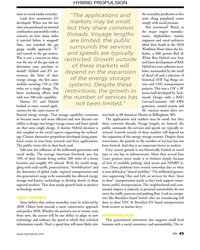 )
March 2019 - Marine News page: 49
)
March 2019 - Marine News page: 49technol- stricted. Growth outside of these markets will depend on ogy. Cleaner alternative propulsion developed along popu- the expansion of the energy storage systems. Despite these lated coasts in tour boat, research and ferry applications. restrictions, the growth in the number of services has not The
-
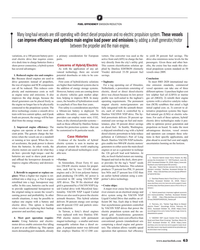 )
August 2019 - Maritime Reporter and Engineering News page: 63
)
August 2019 - Maritime Reporter and Engineering News page: 63systems due to For a tug operating out of IJmuiden, rine emission standards, commercial can all be reduced. This reduces com- the addition of energy storage systems. Netherlands, a powertrain consisting of vessel operators can take one of three plexity and maintenance costs as well However, battery
-
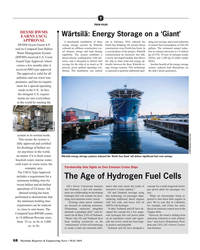 )
May 2019 - Maritime Reporter and Engineering News page: 68
)
May 2019 - Maritime Reporter and Engineering News page: 68APPROVAL A benchmark installation of three out in February 2018 onboard the ating cost savings, and a total reduction DESMI Ocean Guard A/S energy storage systems by Wärtsilä North Sea Shipping AS owned subsea in annual fuel consumption of 528,344 onboard an offshore construction ves- construction
-
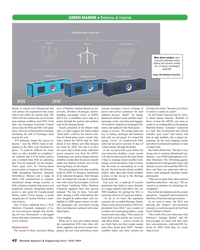 )
May 2019 - Maritime Reporter and Engineering News page: 42
)
May 2019 - Maritime Reporter and Engineering News page: 42others with containerized or compart- have developed the concept in coopera- Fjords deadline. “That sets us apart from other national mentalized energy storage systems, or tion with cruise heavyweights, Carnival Last year saw a ramp-up of systems maritime authorities,” she says. “We see ESS, a battery
-
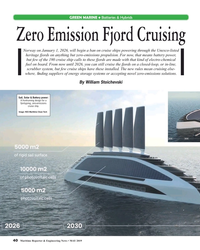 )
May 2019 - Maritime Reporter and Engineering News page: 40
)
May 2019 - Maritime Reporter and Engineering News page: 40, or in-line, scrubber system, but few cruise ships have these installed. The new rules mean cruising else- where, ? nding suppliers of energy storage systems or accepting novel zero-emissions solutions. By William Stoichevski Sail, Solar & Battery power: A frontrunning design for a fjord-going
-
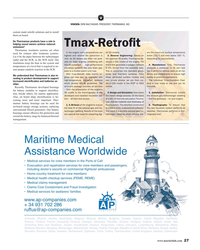 )
May 2019 - Maritime Reporter and Engineering News page: 27
)
May 2019 - Maritime Reporter and Engineering News page: 27can be used for 1. A 3D-Scan of the engine to ensure the insulation. The detailled constrution 6. Thermography: To ensure that on-board energy storage systems, replacing the best ? t of the exhaust gas and tur- is made in Creo, a specialized software. the new insulation system performs as conventional
